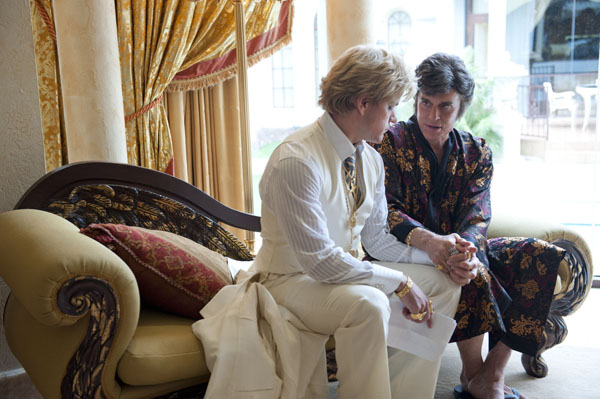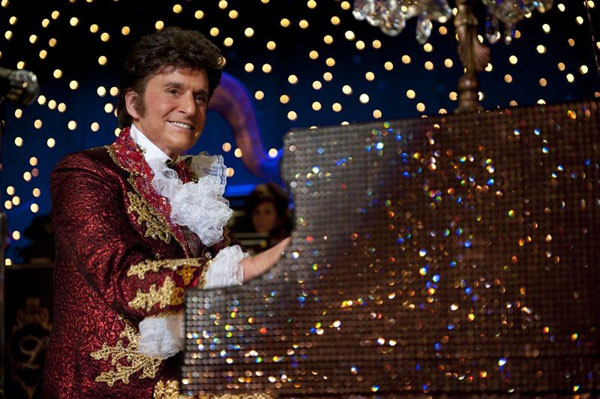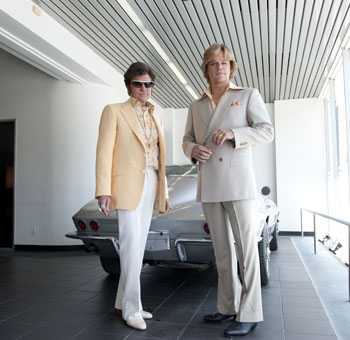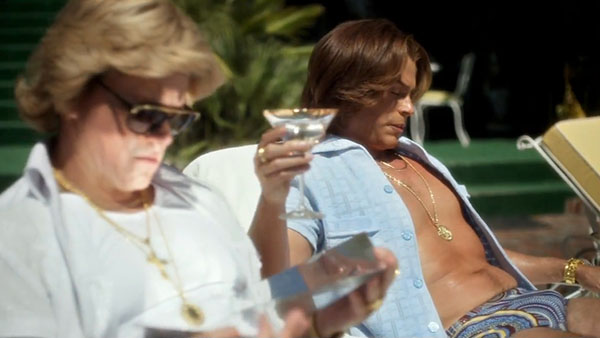“After Side Effects, supposedly his final work for the cinema, Steven Soderbergh has now apparently performed his post-swansong,” begins Peter Bradshaw in the Guardian. “Behind the Candelabra was commissioned for HBO television but is shown here in the Cannes festival competition as a standalone feature-length drama: a bizarre anti-Pinocchio parable in which the power of loneliness and toxic love transform a handsome young man into a deeply unhappy, plump-nosed, cleft-chinned latex doll. It’s the true-life story of the flamboyant pianist Liberace and his young companion and chauffeur Scott Thorson, taking us from the couple’s ecstatic first meeting backstage in Las Vegas in 1976 to Liberace’s death from an Aids-related illness in 1987. The film is mesmeric, riskily incorrect, outrageously watchable and simply outrageous.”
But for David Jenkins at Little White Lies, this is “a standard issue biopic of showtune-cranking, puppy dog-loving sex maniac, ‘Lee’ Liberace, as essayed by Michael Douglas who has been slathered in thick terra cotta prosthetics. It’s a wry piece of counter-casting, especially for an actor whose style, during his heyday, was the embodiment of corporate, slick-haired machismo, and the odd spectacle alone is entirely fitting of this singularly ostentatious entertainer.” That said, the film “lacks that noticeable Soderbergh touch. The subtle sense of subversion that lifts generic material beyond mundane, journeyman hokum is just not there, and while this is certainly a higher class of cinematic biography, it’s still just does its job of hitting all the cosy beats we expect in this type of material.”
For Variety‘s Peter Debruge, it’s “the most bigscreen-worthy film that director Steven Soderbergh has made since Che.” What’s more, as Thorson, Matt Damon “undeniably delivers an astonishing performance… Meanwhile, the choice of Douglas to play Liberace represents a stroke of divine inspiration, reportedly dating back to a spontaneous impression the actor performed on the set of Traffic. More than a decade ago, the role was once linked to Robin Williams, but the genius of Candelabra’s casting is that Soderbergh fills the lead roles with serious actors and then surrounds them with comedic performers: Dan Aykroyd portrays Liberace’s slovenly ’70s manager, Debbie Reynolds plays his heavily accented Polish mother, Rob Lowe parodies his personal fountain-of-youth aesthetic as Liberace’s quack plastic surgeon.”
“[T]his is luxury cinema in the lucid Soderberghian style,” writes the Telegraph‘s Robbie Collin. “His analytical camera turns Liberace’s Vegas mansion, with its golden furnishings and marble columns, into a terrifying mirror-hall of opulence: a place where guilt has somehow morphed into gilt…. Richard LaGravenese’s terrific script allows Liberace to fill in his own personal history in passing conversation—and after five minutes with the man, this seems totally plausible. It also contains dialogue so catty it should probably be spayed. (A notable example: ‘Honey, in gay years you’re Judy during the Sid Luft obese period.’) Damon understands the arc of his role: he’s a blank slate at first, but the scuffs and scratches steadily build up.”
At In Contention, Guy Lodge quotes a delicious line. It’s 1981, and Liberace is hoping On Golden Pond will win Best Picture: “‘I’m so glad Jane Fonda’s dropped all those awful causes and made a nice film with her father,’ he coos primly. ‘Our job is to entertain the world and sell lots of drinks and souvenirs.’ … Much of the film’s blithest humor is used to expose its subject’s deepest social and personal limitations, though its stance is more bemused than vindictive: as well as a touching and tough-minded love story, Behind the Candelabra is a sympathetic study of a man defiantly resisting his own significance. Its own causes, still politically hot a quarter-century after the man’s death, are subtly enfolded into its goggle-eyed celebrity spectacle. It’s entertainment with a capital, fur-lined E, though I suspect Liberace wouldn’t have cared much for it.”
“It’s a winner all around,” finds the Hollywood Reporter‘s Todd McCarthy. “Shot by Soderbergh under his longtime DP moniker Peter Andrews mostly in bright, vivid compositions (he also edited under the name Mary Ann Bernard), the film also benefits from the musical contributions of the late Marvin Hamlisch, in what was presumably his final film work.”
For Ryland Aldrich at Twitch, this is “a generally enjoyable film, even if far too much time is spent on domestic melodrama. Douglas and Damon both fully inhabit their wild characters, slipping comfortably into Ellen Mirojnick’s brilliantly opulent costumes. Production design, hair, and makeup are all immaculate. But even with all of the technical elements a cut above, it can’t be denied that this is a TV movie through and through.”
“With Behind the Candelabra, the 50 year-old filmmaker is coming full circle at Cannes,” notes Anne Thompson. “He landed in competition with his first film in 1989, sex lies and videotape, even though it had played Sundance, and took home the Palme d’Or. ‘It’s not often you get the opportunity to arrange that kind of symmetry,’ Soderbergh told the Huffington Post. ‘It’s funny to think about how long ago that was.'”
“So, are you really retiring?” Tatiana Siegel asks Soderbergh for the Hollywood Reporter. The answer: “I’m sort of taking time off and just trying to determine whether I can come at movies from a different direction. That’s something I think I can’t really explore while undertaking another movie. I think I can explore that philosophically and contextually while making some television. I think I need to take an extended sabbatical from movies while I think about that.”
For the Financial Times, Matthew Garrahan talks with Soderbergh—about retirement, of course—but also about Behind the Candelabra: “It didn’t feel like anything else I had done,’ he says. ‘I wanted to take this interesting, true story and wind it into a combination of Douglas Sirk and Carmen Miranda and every camp melodrama that you’ve ever seen.’ He had the idea for a Liberace film 13 years ago when he was making Traffic with Michael Douglas and Catherine Zeta-Jones, two other periodic collaborators. ‘I asked Michael if he’d ever thought about playing Liberace. He had met him a few times and immediately went into a little routine. I thought: “I’ll just file that away.”‘”
Lynn Hirschberg profiles Douglas for the cover of New York, and he tells her, “When I watch the movie, I forget it’s Matt and me pretty quickly. And soon after that, I forget it’s two guys. The fights, the love—it’s a couple. There’s always that moment in a relationship where somebody has gone too far or they’ve done something that can’t be forgotten, and, suddenly, a little tendon is popped, and it never comes back. The only people you can forgive after something like that is your family…. My father had a tough time watching my death scene in Liberace. He was here when I was sick, and it was very hard for him. When he watched me die in the film, he did not say a lot. My father is 96, and he’s still a really competitive guy. I tease him and say, ‘Let the legacy go on!’ Fathers and sons: They may want to beat you, but they still love you. Who else can you say that about?”
David Segal profiles Thorson for the New York Times: “It’s hard to connect this worn and anxious man in a blue prison shirt to the beefcake grinning in photographs in the late 1970s. Time, an on-and-off meth addiction, several stints in prison and what he describes as Stage 3 colon cancer have taken their toll.”
Updates: “One of the movie’s strengths,” writes Manohla Dargis in the New York Times, “is that it makes transparent how much Liberace, whether at home or onstage—and much as avant-garde artists like Jack Smith did and drag queens still do—was performing homosexuality for what was an often hostile, even dangerous audience. The nice smiling ladies who flocked to his performances may not have known, as someone in the movie jokes, that he was gay. (After seeing him at Radio City Music Hall, my aunt voiced wistful regret that he had never married.) But, as was apparent from the veiled and open sneering, including by critics, there were those who did know or at least guess. Rather than hide or even marry, as other closeted men did (and do), Liberace directly challenged that innuendo by turning himself into a spectacle.”
“Douglas, who goes from preening in front of a theater full of people to being stumbled upon, bald and sagging, fresh out of the shower, plays Liberace as pulled between his need for control and his desire to care and be cared for by someone not just there to freeload,” writes Alison Willmore for Indiewire. “It’s a terrific and vanity-free performance, one that finds the conflicted, aging person underneath the self-embraced caricature while also making it clear that caricature is where Liberace is most comfortable. And Damon matches him by portraying Scott as someone aware that he’s leaping onto a gravy train (‘My eyes are open,’ he tells his concerned foster parents when moving in) but who can’t help but take seriously Liberace’s insistence that he’s the family Scott never had, his yearning and mild avarice inseparable.”
The Chicago Tribune‘s Michael Phillips notes that, at the press conference, “Douglas choked up, briefly, and brought the room to a hush with his acknowledgement that, following his cancer diagnosis, ‘this beautiful gift was handed to me. And I’m eternally grateful.’ … TV, Soderbergh said, owns ‘the cultural real estate’ in America right now. LaGravenese offered this simple comparison between TV and mainstream Hollywood movies: ‘You can have ambiguity in television.'”
Behind the Candelabra “is a movie that earns its place in the Cannes competition roster not just because it’s smart and kitschy and fun and dark, or because it happens to be Steven Soderbergh’s official ‘last’ film before his retirement,” writes EW‘s Owen Gleiberman. “It earns its place because the film is an artfully made and creepily moving love story. Make no mistake: It belongs in a festival that has given us movies like Amour and sex, lies, and videotape.”
“It’s almost unfair how easy Steven Soderbergh makes it look,” writes the Playlist‘s Kevin Jagernauth. “[H]e’s spent the few last years dipping between high grade entertainment (Magic Mike) and accomplished genre films (Side Effects, Haywire) and for his goodbye, he’s more or less combined the two.”
“I’ve been tough on Steven Soderbergh lately,” writes Keith Uhlich, and he links to his Time Out New York reviews to prove it. But today: “Soderbergh has given us a masterpiece. Behind the Candelabra… has many of the hallmarks of late Soderbergh. You’ve got your digital cinematographic palette composed primarily of peaky browns and yellows. You’ve got a highly clinical approach to the subject matter that creates a most unsettling distance (here, two brief, but very graphic plastic surgery scenes encapsulate the sick-inducing dissociation of the director’s post-Limey oeuvre). Yet Soderbergh’s antiseptic touch turns out to be a perfect match for this queerest of real-life tales, the cool-headed complement that allows the story’s knotty emotions to slowly crescendo to a stunning, shattering apex.”
“As fabulous as it should be and not a jot more or less” is the verdict of Amy Taubin, who’s championed many a Soderbergh film, often in the pages of Film Comment. “Soderbergh charts the course of this relationship—the ecstatic sex, the plateau of intimacy, the melodramatic fall from grace—with wit, economy, and a dose of irony a la Douglas Sirk. The camera plan is simple: graceful long dolly shots, locked-down close-ups for tête-à-têtes, and a bit of handheld jiggling when Scott loses it to booze, diet pills, and coke. The editing is pointed and often hilarious, as in the outrageously abrupt cut to Scott enthusiastically fucking Lee up the ass, poppers and all…. In Behind the Candelabra, two major stars play gay all the way and have a conspicuously good time doing it.” Oh, and: “If the jury process here weren’t so political, I’d bet on Matt Damon for Best Actor.”
But at the AV Club, Mike D’Angelo‘s money is on the lead. “Douglas digs deep beneath the flamboyant mannerisms (even as he expertly replicates them) to reveal a universal archetype of ephemeral infatuation, motivated primarily by a toxic combination of lust and fear.”
“The movie might have been a cruel Francis Bacon-style portrait of a predatory male in his late years,” writes Time‘s Richard Corliss, “but Soderbergh and LaGravenese see Behind the Candelabra more as a Disney World trip into ravishing exotica. If this is parody, it’s also consistently sweet-natured and open to poignance.”
Updates, 5/22: “Behind the Candelabra continues the immensely pleasurable social studies that dominate two of Soderbergh’s other recent triumphs,” writes Melissa Anderson for Artforum, referring to Magic Mike and Side Effects.
But for Barbara Scharres, writing at RogerEbert.com, “Behind the Candelabra has all the virtues and flaws of a made-for-TV movie. On the plus side, it is a direct and efficient narrative with no time to waste. There’s no beating around the bush with subtleties, metaphors, or ambiguities, which aren’t Soderbergh’s style in any case. On the negative side, it’s a lead-footed movie with no chemistry between its two leads.”
Updates, 5/23: In the Notebook, Adam Cook ranks Candelabra “somewhere in the middle of his last stretch of movies, above Side Effects and Haywire, below Contagion and Magic Mike. I just can’t see Soderbergh as a finished filmmaker! Maybe even more so than in any other phase of his career, he is refining a particular aesthetic. This isn’t a director in a holding pattern, Soderbergh is constantly looking for new ways of telling stories, new ways of using digital images to articulate characters’ feelings or a film’s mood. He’s so exciting to watch right now, every time he makes a movie there are shots we’ve never seen before. I don’t know if any other American filmmaker is more inventive right now with choosing where to place the camera, how to frame the image, how to use focus, etc.” And Danny Kasman: “It’s interesting you bring up the inventiveness of Soderbergh and his decoupage in a positive light, because of me it is his biggest question mark…. I have a hard time understanding, for the most part…, why he choses a given angle over another, this camera placement over that. In this way, to a degree, he reminds me of mid to late 60s Yoshishige Yoshida: exhibiting a desire to cut to a new angle for the sake of new spatial activation, visual refreshment.”
“There is an Interview With a Vampire quality to Behind the Candelabra,” writes Wesley Morris at Grantland. “An innocent loses himself to a kind of undead creature of the night…. It’s much sadder than camp or satire. It’s true melodrama. Scott becomes the trophy of a man obsessed with youth and statues and things. In the same way that Douglas doesn’t play Liberace’s swishiness, Damon isn’t playing the drug addiction. He inhabits the sinking awareness of romantic demise and really gets at the sting of disillusionment.”
“This incredible movie,” writes Simon Doonan for Slate, “is the don’t-miss of the decade. It is Showgirls plus Casino times GAY. It is so über-gay that while watching it, I, the person who once topped Time Out’s list of the gayest people in New York City, started to feel like Charles Bronson by comparison.”
Updates, 5/24: David Thomson for the New Republic: “Douglas is spectacular; he makes a dull story watchable, he plays to the fascination with gossip, and he lets us keep our cool. He may well win prizes, which is fair enough. But the real triumph of the film is Matt Damon’s Scott Thorson…. I think it’s clear now that he has delivered on the promise he showed in films like Courage Under Fire, The Talented Mr. Ripley, and The Good Shepherd, and which has had to mark time patiently in too much Bourne-ing.”
For Tim Grierson, writing for Paste, “what resonates… is the difficulty in falling in love with someone famous. That person may love you back sincerely, but fame always gets in the way. That’s not a particularly revelatory idea, but Soderbergh and his cast at least find a lively way to say it one more time.”
For New York‘s Matt Zoller Seitz, “for all its frank sex and drug use, gory plastic surgery and moments of pain and humiliation, and the specter of AIDS looming just beyond the film’s disco-era time frame, Behind the Candelabra often feels like a great old Hollywood film—the sort that might have been directed by George Cukor or William Wyler or another unselfconscious master. Debbie Reynolds as Liberace’s mother and Dan Aykroyd as his manager bring a touch of Old Hollywood professionalism as well. Every scene seems carved from marble.”
“How closely does Soderbergh hew to Thorson’s story of life with Liberace?” asks Aisha Harris. “Pretty closely—though the accuracy of Thorson’s book itself is another matter.” At Slate, she takes “a look at a few key characters and events to see just how faithful the movie is to the book.”
Cannes 2013 Index. And you can watch over 100 films that have seen their premieres in Cannes right here on Fandor. For news and tips throughout the day every day, follow @KeyframeDaily on Twitter and/or the RSS feed. Get Keyframe Daily in your inbox by signing in at fandor.com/daily.







